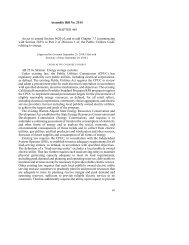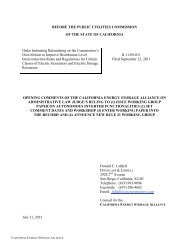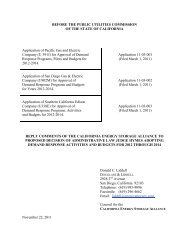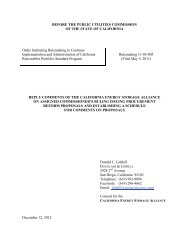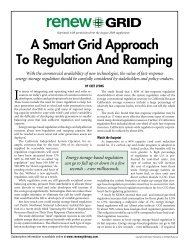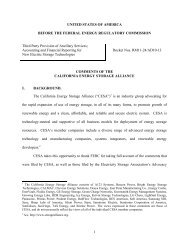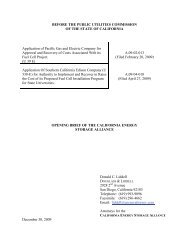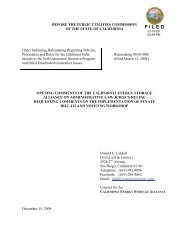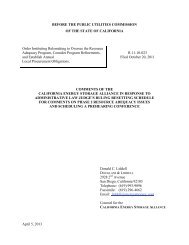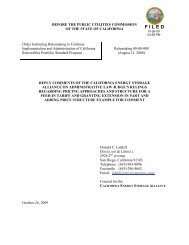02-21-13 CESA Reply Comments - California Energy Storage Alliance
02-21-13 CESA Reply Comments - California Energy Storage Alliance
02-21-13 CESA Reply Comments - California Energy Storage Alliance
- No tags were found...
Create successful ePaper yourself
Turn your PDF publications into a flip-book with our unique Google optimized e-Paper software.
drawing to successful closure. 2<strong>CESA</strong> agrees with Calpine, 3 among others, that the substantialbody of soon-to-be complete collaborative work on cost-effectiveness will provide a criticalelement of the evidentiary foundation required by the Commission for evaluation of procurementpolicy options. <strong>CESA</strong> notes that the Interim Staff Report 4 states:“The purpose of this Interim Staff Report is not to make specificrecommendations on any of the barriers or policy options at this point intime, but rather to seek comment from stakeholders based on the work preparedin the proceeding up until this point. Staff expects stakeholder comments,future workshops, and subsequent staff proposals to all be part of the record ofthis proceeding.” (p. 3).<strong>CESA</strong> also notes that informed speculation and sincere expressions of opinion bycommenting parties, while appropriate at this stage of the proceeding, pale in significance whencompared to the substantial evidence already in the record that can reasonably support any of thewide range of policy decisions that the Commission may make once the record is closed.Furthermore, the Commission can and should inform its policy determinations and decisionsregarding procurement planning and goal setting in this proceeding with references to otherrelated Commission decisions and proceedings. In addition to the substantial evidentiary recordproduced to date in this proceeding, the Commission should take official notice of (as oneexample) the Track 1 decision it arrived at very recently in the Long-Term Procurement Planningproceeding, 5 and others as appropriate.<strong>CESA</strong> supports the timeline that was introduced by the <strong>Energy</strong> Division Staff at theWorkshop, and looks forward to commenting on the final staff proposal that is expected to beproduced for public comment in the coming few months. In pertinent part, the timeline proposedby the <strong>Energy</strong> Division staff specifically provides as follows :2 The current Draft Workplan for Cost-Effectiveness Study, dated February 8, 20<strong>13</strong>, is subject to revision, but isattached as Appendix A to these reply comments as a point of reference.3 <strong>Comments</strong> of Calpine, filed February 4, 20<strong>13</strong>.4 <strong>Energy</strong> <strong>Storage</strong> Phase 2 Interim Staff Report, January 4, 20<strong>13</strong>.5 (D).<strong>13</strong>-<strong>02</strong>-015, issued January <strong>13</strong>, 20<strong>13</strong>.2
“1 st Quarter 20<strong>13</strong>Glossary of Commonly Used Terms - Some parties have expressed adesire for a common set of definitions to terminology that is frequentlyused in this proceeding.<strong>Energy</strong> <strong>Storage</strong> Cost-Effectiveness Analysis – a document thatoutlines how cost-effectiveness for storage will be approached,complete with (1) categories of benefits to be considered (2) categoriesof costs to be considered and (3) a set of underlying assumptions to beused in the analysis including a ‘baseline’ of status quo solutions tocompare against storage solutionsSummary of preliminary cost-effectiveness analysis from exercisingthe modeling tools.Finalized Use Cases to incorporate cost-effectiveness analysis(recognizing that these documents may continue to evolve to fit futureprocess needs).2 nd Quarter 20<strong>13</strong>Staff proposal presenting cost-effectiveness analysis, recommendedprocurement policies, and guidance on cost-effectiveness methodologyfor future procurement application.”Third, the Commission should establish as a general policy guideline to Load ServingEntities (“LSEs”) that cost-effective and viable energy storage resources should be the mostfavored energy resource available to meet <strong>California</strong>’s system needs. This approach would beentirely consistent with the concept proposed in the comments of Pacific Gas and ElectricCompany (“PG&E): 6“To the extent that any particular resource or class of resources provides thehighest value, there would be a clear market signal though procurement.PG&E suggests, consistent with <strong>CESA</strong>’s recommendations, that:Utilities will be required to consider storage; andIf storage projects are not found to be cost-effective, utilities will haveto demonstrate to the Commission and the Procurement Review Group6 Pacific Gas and Electric Company <strong>Comments</strong> on the Interim Staff Report in Phase 2, filed February 4, 20<strong>13</strong>.3
(PRG) that any proposed storage projects are not cost-effectivecompared to other bidders. (p. 9).”<strong>CESA</strong> asks the Commission to support PG&E’s approach in principle and the distinction <strong>CESA</strong>draws between “preferred resources” listed in the Loading Order and a “most favored resource”policy preference for the flexible operating characteristics of energy storage resources.II.MISCHARACTERIZATIONS OP <strong>CESA</strong>’S WORKSHOP PRESENTATION INOPENING COMMENTS FILED BY PARTIES SHOULD BE DISREGARDED BYTHE COMMISSION.A. Southern <strong>California</strong> Edison.1. SCE’s Comment: Percentage-Based Procurement “Target” Lacks Any ClearMethodology or Principles.<strong>CESA</strong>’s Response: The goals included in the presentation at the Workshop were clearlylabeled: “Examples.” As explained in its Opening <strong>Comments</strong>, <strong>CESA</strong> has recommended anapproach to goals based upon system need.2. SCE’s Comment: Contrary to <strong>CESA</strong>’s presentation, most energy storage benefitsmay be monetized today, or will be monetized when ongoing regulatory reformsare complete.<strong>CESA</strong>’s Response: <strong>CESA</strong> disagrees with the assertion that many of these services aremonetized, per our comments below. However, there is a larger issue: it is unclear if utilityprocurement processes value, or correctly evaluate, the benefits listed, due to lack oftransparency on utility procurement processes to outside stakeholders. In these cases, it does notmatter if an energy storage system would be able to capture the benefits if the procurementprocess does not recognize the benefits. If the benefits are not recognized during procurement,then energy storage systems will appear as though they are not cost-effective. They will not beprocured at appropriate levels for utilities and ratepayers, and energy storage systems will haveinsufficient opportunity to demonstrate that they can capture those value streams. <strong>CESA</strong> expects4
the cost-effectiveness work in this proceeding to show that certain applications of energy storagewill, in fact, be cost-effective when all benefits are correctly accounted for.3. SCE’s Comment: “Grid Benefits,” including “Reduced Fossil Fuel Use” and“Increased efficiency of installed generators,” generally refers to the emissionsreductions gained when energy storage displaces or abates conventional generation orenhances generation efficiency. <strong>CESA</strong> displayed a fundamental misunderstanding ofthe benefits captured in the daily energy markets.<strong>CESA</strong>’s Response: <strong>CESA</strong> agrees that emissions reductions are gained when energystorage displaces or abates conventional generation or enhances generation efficiency. However,these benefits are not fully monetized at this time. For example, the following factors must beaccounted for:a. Historic ancillary service market prices commonly used to evaluate generationprojects do not include the price of greenhouse gasses (“GHGs”), nor do theyaccurately reflect the long term increases in the price of GHG offsets requiredto fulfill AB32 requirements.b. Capacity values do not currently account for expected future prices of GHGoffsets. SCE assumes carbon offset prices of $10 per ton based upon 2012auction prices. However, evidence in the long term procurement planningproceeding shows that carbon offset prices are projected to be $36.65 per tonby 2<strong>02</strong>0. 7 When resources with greater than 20-year lifetimes are beingconsidered, it is critical that long term carbon prices are taken into accountwhen evaluating cost-effectiveness.The developers of many generating resources are compensated through long-term powerpurchase agreements (“PPAs”), not through market participation. For example, generation-sitedenergy storage systems collocated with fossil generators can greatly increase the output of thosetraditional fossil generators, but established PPA rates do not change if an on-site energy storagesystem is able to provide more power output. Thus, the developers of generation-sited energystorage systems are unable to capture the value of the increased capacity. The result is that7 See, D.12-12-010, p. 36-37.5
utility customers are deprived of resources which provide energy at lower cost than traditionalassets. A proposed solution, offered at the Workshop, and in comments filed in this proceedingis to ensure these generators are able to receive a separate contract for the power produced by thegeneration-sited energy storage systems.4. SCE’s Comment: “Distribution Peak Capacity Support (Deferral)” and “DistributionOperation (Voltage/VAR Support)” refer to a storage device’s ability to reduce peakload and the ability to provide voltage and volt-ampere reactive (“VAR”) support.These benefits may allow system planners to defer system capacity upgrades or theinstallation of power quality equipment such as capacitors. Because a utility owns itsdistribution assets, the utility fully monetizes its distribution benefits by evaluatingthe project’s impact on the distribution system to establish and estimate the abatedcosts.<strong>CESA</strong>’s Response: <strong>CESA</strong> agrees with SCE that energy storage may “reduce peak load”and “provide volt-ampere reactive (“VAR”) support. <strong>CESA</strong> also agrees that, “the utility fullymonetizes its distribution benefits.” However, this statement does not apply to a customerinstalling an energy storage system behind the meter. The customer is not able to monetizeeither the distribution peak capacity support or distribution operation benefits provided to theutility by the energy storage resource. Because the customer cannot monetize these benefits, it isless likely that customers will install behind the meter energy storage resources than if they wereable to monetize these benefits.5. SCE’s Comment: “Locational Flexibility” and “Modularity” will be monetizablethrough a least-cost best-fit procurement process. Locational flexibility could reducesiting costs, resulting in a lower bid price that increases the likelihood of selection.Alternatively, locational flexibility could be incorporated on the “best fit” side: aresource that can be sited in a preferable location will be valued incrementally higher.Similarly, modularity could also be monetized through the least-cost best fit process.A modular resource could allow the developer to build precisely according to thedefined need, so as to maximize needed benefits while minimizing costs.<strong>CESA</strong>’s Response: There are additional benefits of locational flexibility and modularitywhich are not accounted for in SCE’s comment. Locational flexibility and modularity are bothcharacteristics of many energy storage systems, which can also allow them to be moved to a6
different location during the course of their project life. This means that an energy storagesystem might be placed at one high value location, and then moved to another high valuelocation during its lifespan. Taking advantage of the mobility of energy storage is a key benefitfor certain applications such as distribution deferral. The reduced risk of achieving energystorage benefits due to their ability to be readily moved and/or modularized is not addressed bySCE’s comment.6. SCE’s Comment: <strong>CESA</strong> cited benefits that are too vague to be meaningful, or arecommon to both conventional and storage resources. For example, it is unclear towhat “Increased Integration of Renewable Resources” specifically refers;“integration” of renewable energy can mean any number of activities, including somebenefits provided by conventional generation. Similarly, any resource provides somedegree of “Grid Reliability,” which encompasses some of the functions noted above.SCE agrees that storage provides benefits that are related to these concepts, it makesno sense to broadly claim that storage is uncompensated for them.<strong>CESA</strong>’s Response: Contrary to SCE’s comment, energy storage resources may provideclear benefits which are not currently compensated. The benefit of increased integration ofrenewable resources refers to three unique capabilities of energy storage which are critical torenewable integration. The first is the capability of energy storage systems to store renewableenergy that might otherwise be wasted. The second is the capability of energy storage tobalance, firm, and shape renewable energy output without producing additional emissions.Finally, by shaping and scheduling renewable energy production, energy storage has thepotential to better utilize existing transmission and distribution capacity. The critical issue is that<strong>California</strong> is procuring renewables to achieve AB 32 and Renewables Portfolio Standard(“RPS”) goals. If those renewables are balanced by fossil resources, then achieving high RPSgoals becomes a losing battle, where increased renewables requires adding more fossil fuelgeneration, which requires adding additional renewables. In assisting with renewable gridintegration, energy storage allows for greater penetration of renewable energy on the grid, and7
increased utilization of both renewable energy assets and existing transmission and distributionassets paid for by ratepayers.The grid reliability benefit provided by energy storage is the ability for an energy storageresource to continue to provide power to customers in a grid outage. In addition, many fastresponse energy storage systems may be rapidly deployed to prevent large grid outages in thefirst place. Compensation rules for these unique benefits of energy storage are unclear, at best.7. SCE’s Comment: <strong>CESA</strong> asserted large-scale procurement funded by ratepayers canhelp improve economies of scale and reduce costs. While this is true, spendingenormous sums of utility customer money for the sole purpose of making somethingless costly in the future is a bad proposition, especially when the net benefits ofstorage are yet to be demonstrated. While better economies of scale is a helpfulsecondary benefit once a resource is found to be cost-effective, it is ultimately not theutility customers’ obligation to improve the cost structure of competitive developersand manufacturers.<strong>CESA</strong>’s Response: This comment implies that <strong>CESA</strong> has advocated for procurementgoals for the sole purpose of improving economies of scale and reduce cost. Quite the contrary!<strong>CESA</strong> advocates for procurement goals because it is a proven way of achieving focused resultsby a broad set of stakeholders. The results <strong>CESA</strong> seeks are consistent with that of SCE andmany other stakeholders - -a cleaner, more reliable, affordable, efficient and secure electricpower system for <strong>California</strong>. Appropriate procurement goals will provide the necessary marketsignal to stimulate even greater investment into energy storage solutions, financing andmanufacturing capacity … which will result in greater economies of scale and even lower costsin the future, creating a virtuous cycle of enabling even more applications of energy storage tobecome cost effective and viable. It is important to note that procuring large amounts ofconventional fossil fuel generation capacity over the next decade will have a rate payer impact aswell … and in particular, will increase the ‘switching cost’ of moving to a cleaner alternative.<strong>CESA</strong> is suggesting that the Commission instead support the procurement of lower-emissions,8
more flexible energy storage assets that are being shown to be more cost-effective thantraditional assets.8. SCE’s Comment: <strong>CESA</strong>’s Presentation Distorts the Results of the CAISO’s 33%RPS Studies <strong>CESA</strong> selectively quoted a slide taken out of context from a CAISOpresentation to support the false claims that “Under business as usual, the 33% RPSwill not reduce GHGs” and “GHG/Fuel use increases when 33% RPS happenswithout grid-connected storage available. <strong>CESA</strong> misrepresented the environmentalbenefits of moving to 33% renewables prior to inclusion of storage on the grid. SCEfurther states, while energy storage has some potential to decrease emissions incertain applications, <strong>CESA</strong>’s implication that emissions reductions will not occurwithout storage is entirely false.<strong>CESA</strong>’s Response: Unfortunately SCE seems to have misunderstood or taken the <strong>CESA</strong>presentation out of context by ignoring <strong>CESA</strong>’s reference to “business as usual” in the slide.<strong>CESA</strong> agrees with SCE that the RPS has significant emissions benefits, and agree that energystorage does have potential to decrease emissions if effectively utilized. The recent slowdown inRPS procurement and implementation is a strong indication that under business as usual, the fulland best benefits from the RPS are not being captured as best they could, and, utilizing fossilgeneration to balance renewable energy is a ‘lost emissions reduction opportunity.’ The CAISOslide in <strong>CESA</strong>’s presentation identified a scenario where achieving <strong>California</strong>’s 33% RPS goaldid not result in reduced fuel burn in <strong>California</strong>. <strong>CESA</strong> did not mean to imply that that was theonly scenario possible.<strong>CESA</strong> is not saying that energy storage is required to get reductions, but that energystorage is essential to achieving reduction effectively. As the volatility of the grid increases(either due to increased intermittent generation or increased high demand intermittent loads suchas electric vehicles), non-GHG-generating buffering is needed to reduce GHGs. Running fossilgenerators at minimum loads in standby mode or at high ramp rates generates a tremendousamount of GHGs. This is simply not necessary. In contrast, most energy storage resources donot require minimum load levels or wasteful minimum idling levels. Their energy output comes9
from energy taken from the grid, which becomes increasingly clean as renewable penetrationincreases. <strong>CESA</strong> believes that a careful study of alternative emissions scenarios under AB 32will clearly demonstrate that with use of cost-effective energy storage, the amount of emissionswill likely be significantly reduced by 2<strong>02</strong>0, compared to the cases without energy storage.Procurement of too much unnecessary gas now will have negative emissions consequences formany years. Cost-effective energy storage is an essential tool to lower overall cost risk, andfurther add value to the 33% RPS goal, and beyond.9. SCE <strong>Comments</strong>: SCE strongly objects to implications that investor-owned utilities(“IOUs”) lack either the will or the ability to properly consider new technologies suchas storage. <strong>CESA</strong>’s claim that the “inertia of business-as-usual procurement must beovercome”5 ignores these ongoing efforts by utilities to transform and advance utilityprocurement processes as the market landscape continues to develop. SCE and otherutilities are continually adapting to the changing energy landscape, changingrequirements of the grid, and evolving public policy objectives. (page 6)<strong>CESA</strong> Response: <strong>CESA</strong> would like to clarify its statement from the workshop. <strong>CESA</strong>did not mean to imply that ‘IOUs” lack the will or the ability to properly consider new resourcessuch as energy storage. Clearly this is not the case, as SCE and other utilities have successfullyimplemented a broad range of pilot projects to date, and, in the case of SCE, proactively initiatedin-depth study of the role of energy storage in the electric power system. What <strong>CESA</strong> intendedto convey was the idea that new energy storage resources have a different risk profile, from aninvestor standpoint, as compared to traditional fossil based resources. In the business world,higher risk investments typically enjoy a higher return. <strong>CESA</strong> wanted to point out that underexisting utility compensation mechanisms there is currently no way for utilities to be fairlycompensated for the higher risk profile – both real and perceived – of future energy storageprocurement. <strong>CESA</strong> recommends that this be factored in when considering energy storagepolicy development.10
B. Jack Ellis.Jack Ellis’ <strong>Comments</strong>: <strong>CESA</strong> has also made no attempt to quantify any of thecapacity and ancillary benefits that storage built for peak capacity could provide,so there’s no way to compare the cost of achieving <strong>CESA</strong>’s quantitativejustification for the 1,500 MW of storage it suggests be targeted toward customerbill management.<strong>CESA</strong>’s Response: As an interested party with relatively little experience with gridconnectedenergy storage, Jack Ellis’ comments are apparently made with insufficient context asto all of what is actually happening in this proceeding and should be regarded as such by theCommission. <strong>CESA</strong> has been working collaboratively with <strong>Energy</strong> Division staff and otherstakeholders, including the utilities, on a comprehensive energy storage cost effectivenessworkplan that will be used to evaluate the cost-effectiveness of each of the energy storage usecases developed in Phase 1of this proceeding. Obviously, since this work is underway and hasnot been completed <strong>CESA</strong> was not able to quantify the capacity and ancillary services benefitsdescribed in its Opening <strong>Comments</strong>. This is also the primary reason why <strong>CESA</strong> has notintroduced any specific procurement targets to date, as it would be premature to do so before thiscost-effectiveness work has been completed.C. Calpine.1. Calpine’s Comment: <strong>Energy</strong> storage can increase GHG emissions depending on:(1) the extent to which it requires significantly more energy to charge than it cansubsequently discharge; and (2) the mix of resources that are generating when it ischarging and the resources that are displaced when it discharges. For example, ifenergy storage is charged using electricity that is produced from coal (or coalbasedimports as the case may be in <strong>California</strong>) and displaces electricity that isproduced from comparatively efficient and clean gas- fired plants when it isdischarged, then energy storage has the potential to increase GHG emissions. It isimportant that resources, such as energy storage, are not added to the LoadingOrder on the basis of assumed GHG reductions until it is demonstrated thatmaterial GHG reductions will, in fact, be realized. (p. 5)<strong>CESA</strong>’s Response: Calpine’s comments are correct in that the GHG emissions profile ofenergy storage is dependent on the source of the energy used to charge the energy storage11
system. However, in the case of <strong>California</strong> it is highly unlikely that energy storage will increaseGHG emissions for several reasons:a. In its comments emphasizing the importance of including carbon in the costeffectiveness calculation for energy storage, 8 Calpine calculated that an energystorage system needs to be at least 50% efficient to be on par with the costs andemissions reduction potential of a combined cycle gas turbine (“CCGT”), in ascenario where it displaces a high heat rate gas plant that would otherwise beneeded if the energy storage was not dispatched.b. Fortunately, round-trip efficiencies of most energy storage resources are muchmore efficient than that example. Many common hydro resources, batterychemistries, and mechanical energy storage systems achieve are over 80% AC toAC round trip efficiency. In its Opening <strong>Comments</strong>, Alton <strong>Energy</strong> demonstrateda very simple methodology for quantifying the avoided CO2 emissions fromhigher heat rate generators. Alton points out that there are thousands ofmegawatts of gas combustion turbines with over a 11,000 heat rate ranging upover 15,000 heat rate generators still operating in <strong>California</strong>. Alton demonstratesthat even in a scenario where the charging energy was sourced by 100% gas (for abulk energy storage with a round-trip efficiency of 80%), specifically sourcedfrom CCGTs at a heat rate of 7,000, that there would be substantial CO2emissions avoided when displacing gas plants with a heat rate of 9,000 or higher. 9It is clear, both through Calpine’s example and references by SCE that energy8 <strong>Comments</strong> of Calpine, p. 6-7.9 Alton <strong>Energy</strong> <strong>Comments</strong>, filed February 4 t , 20<strong>13</strong>, pp. 5-7.12
storage can reduce emissions and help <strong>California</strong> reach its AB 32 goals in a timelyand cost-effective manner.c. <strong>California</strong> is in the process of reducing its reliance on coal generation. Rather, thegeneration used at the margin is very efficient CCGT generation and gas peakers– not coal.d. <strong>California</strong>’s electricity mix is getting cleaner over time, not dirtier – especially itsnighttime mix, as more and more wind generation comes on line. <strong>Energy</strong> storagecan provide a useful ‘load’ for any excess wind or solar generation and so has theability to be even cleaner than <strong>California</strong>’s baseline average electric mix.III. COST-EFFECTIVE AND VIABLE ENERGY STORAGE RESOURCESSHOULD BE CONSIDERED THE MOST FAVORED RESOURCE AVAILABLETO MEET SYSTEM NEEDS.<strong>CESA</strong> reaffirms its consistent position that the Loading Order cannot be unilaterallyaltered by the Commission. 10However, given energy storage’s potential to reduce GHGs and itshighly flexible and modular capabilities it should be considered a “most favored resource.” Thisproceeding is an excellent platform to demonstrate the benefits of energy storage, to show theneed and urgency for it to be included in the Loading Order, and demonstrate that energystorage does offer many of the same attributes of a preferred resources – including GHGreduction. <strong>Energy</strong> storage has not been included in Loading Order to date for the simple reasonthat its importance was not considered or understood when the Loading Order was originallyestablished. In addition to its emissions reduction potential, energy storage is essential to realizeand maximize the utilization and value of Preferred Resources.10 See, e.g. <strong>Reply</strong> <strong>Comments</strong> of the <strong>California</strong> <strong>Energy</strong> <strong>Storage</strong> <strong>Alliance</strong> on Administrative Law Judge’s RulingSeeking Comment on Workshop Topics, filed October 23, 2012, in R.12-03-014.<strong>13</strong>
<strong>CESA</strong> agrees with the CAISO’s comments in the LTPP to the effect that dispatchableresources, like demand response and energy storage, must help balance supply and demand; andnon-dispatchable resources, like energy efficiency or behind the meter generation, musteliminate demand that would otherwise have to be balanced with supply. In the end, allresources, regardless of size, configuration, or type must fundamentally deliver the operatingcharacteristics that can measurably support grid reliability by helping to balance supply anddemand or by eliminating the need to do so. 11<strong>CESA</strong> also agrees with the CAISO that at aminimum, dispatchable resources must provide energy when and where needed, and for howmuch is needed to balance the grid and maintain system stability based on ISO instructionsand or submitted schedules.The sine qua non of energy storage that should be considered when procuring allnew dispatchable resources is its defining operating characteristic: that many energystorage technologies can be available to the grid at an operationally ideal zero PMin(minimum load). 12Finally, <strong>CESA</strong> agrees with the CAISO that: “The ability to minimizePMin is highly beneficial for reliability and minimizing cost as the ISO anticipates periods ofsignificant over-generation with increasing amounts of energy served by intermittent resources.Lower PMins will help minimize over generation and the potential for high negative priceswhere market participants (and ultimately consumers) pay to have excess energy consumed orexported. Minimizing minimum load as an operating characteristic is an importantconsideration in future procurement solicitations for dispatchable generation resources. Allother benefits of energy storage aside, no other resource can cost-effectively and reliablydeliver a PMin of zero.11 See, e.g. Comment s of the <strong>California</strong> Independent System Operator, filed October 9, 2012.12 7 PMin is the minimum normal energy producing capability of a resource, i.e. the lowest operating level aresource can sustain and still be dispatchable.14
IV.CONCLUSION.<strong>CESA</strong> appreciates this opportunity to provide these reply comments, and looks forwardto continuing to work with the Commission and parties to achieve the goals of this proceeding.Respectfully submitted,Date: February <strong>21</strong>, 20<strong>13</strong>Donald C. LiddellDOUGLASS &LIDDELLCounsel for theCALIFORNIA ENERGY STORAGE ALLIANCE15
APPENDIX A
DraftWorkplanfor<strong>Energy</strong><strong>Storage</strong>CostEffectivenessStudyinR.1012007Version0.6February8,20<strong>13</strong>
1IntroductionThisisaworkinprogressworkplanandhasbeendevelopedwiththehelpofvolunteersrepresentingparties in the <strong>Storage</strong> rulemaking. It describes the costeffectiveness analysis/study that Staff isconducting currently for storage use cases with the help of <strong>Storage</strong> OIR stakeholders and industrymodelingtools.Theintentofthestudyistogeneratemeaningfulcosteffectiveness(CE)dataquicklyinalimitedtimeforselectusecasestoinformtheconsiderationofvariouspolicyoptionsinthe<strong>Storage</strong>Rulemakingforadvancingprocurementofenergystoragesystems.Theworkpaperisdividedintosixsections,correspondingtothefollowingtopics:1. Introduction2. Prioritizedlistofselectedusecasestoanalyze3. Overall“framework”andapproachtobeusedforCEanalysisofusecases4. Summaryofbenefitstreamsandcostfactorsapplicabletotheusecaseanalysis5. Limitationsorothercaveatsrelatedtomodelingtools(EPRI’sESVT,DNVKEMA)6. InputtemplatesfordrivingmodelingtoolstogenerateCEresults,populatedwith:a. Directcost&benefitinputs(sourcecitationsforinputswillbeincludedwherepossible)b. “Global”parametersaffectingcosts/benefits(discountrates,inflation,etc.)c. Suggestedmodelingscenarios(basecase,lowcase,highcase)d. SuggestedsensitivityanalysisItisalsoimportanttonotewhatthisCEstudydoesNOTdo.Itdoesnot: establishaCPUCendorsedstorageCE“methodology” makeanyfactualfindingsregardingstorageCE(suchfactualfindingsareappropriatelymadeinotherCPUC proceedingsinvolvingIOUapplicationsseekingapprovalofaproposedrealworldprojectorprogramwithspecificbenefitsandcostestimates) attempt to pursue an exhaustive, comprehensive, analytically precise and rigorous study; bynecessityandtoexpedite,thestudyeffortwilluseshortcutsandreasonablecompromisesandrelyonavailabletoolsasisTheCEframeworkutilizedinthisstudyandthestakeholderlearningfromthisprocesscouldinformthedevelopmentofapplicationspecificCEmethodologiesusedtoevaluateenergystorageprocurementbyIOUs.ItisexpectedthatresultsbasedonEPRI’stoolwillbeavailablebyMarch,followedbyresultsbasedonKEMA’stools.StaffexpectstoholdaworkshopinMarchApriltoreviewtheCEstudyresults,followedbyaStaffreportinApril.2PrioritizedUseCasesGiventhelimitationoftimeandresources,basedonstakeholderfeedback,complexityoftheusecase,potential for new insights, availability of data, and understanding of model capabilities, Staff hasprioritizedtheusecasesintheorderinwhichtheyshouldbeanalyzedtoefficientlyusethelimitedtimeavailable in the proceeding to complete the CE study (basically, during 20<strong>13</strong>Q1: see timeline detailsnotedinSection5.3oftheCPUCStaffPhase2InterimReport).Usingaprioritizedapproach,thegoalistolearnfromtheanalysisoftheinitialpriorityusecasesandapplythatlearningtosubsequentusecases
totheextenttimepermits.BelowisaproposedprioritizedlistofselectusecasestobeanalyzedintheCEstudy(andthesuggestedtechnologyalternativestobecomparedfortherespectiveusecases):Phase1Phase2Deferred Priority UseCasePrioritizationTConnectedBulk<strong>Storage</strong>Distribution<strong>Energy</strong><strong>Storage</strong>BehindtheMeter<strong>Energy</strong><strong>Storage</strong>PrimaryBenefitConventionalTechnologyPriority#1<strong>Storage</strong>TechnologyPriority#1<strong>Storage</strong>TechnologyPriority#<strong>21</strong> PeakerPlant Capacity,<strong>Energy</strong>,A/SCT Battery FlowBattery2 AncillaryA/S CT Flywheel BatteryServicesOnly3 BaseLoadPlantCapacity,<strong>Energy</strong>CCGT PumpedHydroCAES4 Distributed Upgrade Circuit Battery FlowPeaker deferral& Upgrade&BatteryMarket$ CT5 Substation VoltageReg Circuit Battery Sited<strong>Storage</strong>Upgrade6 Community VoltageReg Circuit Battery <strong>Energy</strong><strong>Storage</strong>Upgrade789BehindtheMeterBehindtheMeterUtilityControlledPermanentLoadShiftingBillMgt/AvoidCost,Market$BillMgt/AvoidCost,Market$,GridRelBillMgt/AvoidCost,GridRelCircuitUpgrade&CTCircuitUpgrade&CTBatteryBatteryFlowBatteryFlowBatteryCT Thermal Battery 10 EVCharging Circuit Battery Upgrade11 VERSited<strong>Storage</strong>CT Battery FlowBattery12 GasTurbineCT Thermal BatterySited<strong>Storage</strong><strong>Storage</strong>TechnologyPriority#3FlowBatteryThermalThelastthreecaseshavebeendeferredasitisfeltthattheyappeartobetoocomplexrequiringhigheffortrelativetothelimitedmodelingcapabilitiesavailable.
3CostEffectivenessFrameworkThis section describes the proposed CE “framework” to be used for assessing the CE of selected usecases.Theframeworkisbasedonassessingcostsandbenefitsofaproposedusecasesolutionfroma“TotalResourceCost(TRC)”perspectiveusingthefollowingapproach:1) Assumethereisanunmetsystemneedthatrequiresincrementalinvestmentinanewresourceto address the need.The resource addition could be a conventional technology or a storagealternative.2) DetermineandcomparelifecyclenetbenefitonaCDCF 1 basisoftwo“comparable”solutionsfora“usecase”(onebasedonconventionaltechnologyandtheotherbasedonstoragetechnology)usinganavailablemodelingtool,subjecttomodellimitations(suchasanybenefitorcostfactorsnotconsideredbythemodel). 2 3) Make adjustments to modeling input values, if/where possible, for benefits or costs notconsideredbythemodel,orqualitativelynotethepotentialimpactofthesefactors.4) Separatelyconsider,viastakeholdercomments,otherpotentialbenefitsorcostsassociatedwithattributesnotalreadyconsideredabove.Aglossaryofsometermsusedabovefollows.NetBenefitsComparison:meanscomparingnetbenefits(NB)oftwo“comparable”solutionsfora“usecase”, with one solution based on conventional technology and the other solution based on storagetechnology,whereNB A ofsolutionA=TB A (totallifecyclebenefitsofsolutionA)–TC A (totallifecyclecostsofsolutionA).Thisisfurtherillustratedbelow:NetBenefitFramework Time Yr1 Yr2 YrNBenefitsCapacityRevenuesforRAcontributions<strong>Energy</strong>MarketRevenues(includesarbitrage)Ancillary Service Market Revenues(regulation, spin, nonspin, ramping, blackstart)OtherCostsFixed Costs (capital costs, labor, financing,ROE,etc.)FixedO&M(staff,etc.)Variable O&M (charging fuel, efficiencylosses, emissions, wear & tear, startup,operations,maintenance,etc.)NetBenefit=Benefits–Costs1 CDCF=cumulativediscountedcashflow2 Inotherwords,anincrementalstoragesolutionistobecomparedwithanincrementalconventionalsolution,notwithalreadyexistingresources.
NotethefollowingobservationsregardingNB(netbenefits): IfNBofasolutionequalsorexceedszero,thesolutionisconsideredcosteffective. IfNB A >=NB B (evenifnegative),solutionAisconsideredsuperiortosolutionBintermsofCE.However,itshouldbenotedthatprocurementdecisionsofteninvolveadditionalconsiderationsbeyondCEindeterminingthebestsolution. Incaseswherethecostofstoragesolutionisdifficulttoestablish,itmaybeofinteresttolookat“breakevencostanalysis.”“Comparable” solutions: means two solutions (based on different technology alternatives) “sized” todeliverthesamevalueintermsofsomeprimarybenefit(s)[however,TBofthesolutionstillincludesvaluesofbothprimaryandothersecondarybenefitsrealizedbythesolution].Thisisillustratedviatwodifferentexamplesbelow:a) Exampleofpeakcapacityasthe“normalized”primarybenefit:ComparethenetbenefitsofagasCT peaker plant vs. an energy storage project, both sized to provide 100MW of usable peakcapacityunderspecifiedconditions.Notethatthenameplatecapacitiesofthetworesourcesrequiredtodeliver100MWusablepeakcapacitywillbedifferent:specifically,theCTnameplatemust be greater than 100MW to allow for temperaturebased capacity deration in order toeffectivelydeliver100MWunderhightemperatureconditions.b) Exampleofflexiblecapacitysuchasthe“normalized”primarybenefit:Comparea100MWCTpeakerwithaminimumoperatinglevelof20MW(providing80MWofdynamicrange)to40MWofenergystorage(whichcandeliverthesame80MWofflexiblerangeduetoitsabilitytocharge40MW"down"anddischarge40MW"up").BreakEvenCostAnalysis(<strong>CESA</strong>suggestedoption):InthecasewhereTCofastoragesolutionmaybedifficult to establish (due to lack of data or consensus, for example), an alternative approach is todetermine what the “break even cost” would be for a given use case based on the maximum TC S satisfyingtheinequality:TC S
4SummaryofBenefitsandCostsApplicabletoUseCasesThelistofallbenefitsapplicabletoausecaseisbasedontheanalysisalreadycompletedbystakeholdersandsummarizedinthecorrespondingUseCaseDocument(seeStaffInterimReport):TBD:Complete/CorrectthetablebelowEndUse/BenefitStreamTConnectedBulk<strong>Storage</strong>Distributed<strong>Energy</strong><strong>Storage</strong>BehindtheMeter<strong>Energy</strong><strong>Storage</strong>GensitedPeakerPlantAncillaryServicesOnlyBaseLoadPlantDistributedPeakerSubstationSited<strong>Storage</strong>Community<strong>Energy</strong><strong>Storage</strong>BehindtheMeter<strong>Storage</strong>BehindtheMeterUtilityControlledPermanentLoadShiftingEVChargingVERSited<strong>Storage</strong>GasTSited<strong>Storage</strong>Generation/WholesaleMarketsVERTransmissionDistributionBehindMeterElectric<strong>Energy</strong>TimeShift(Arbitrage) P P S FrequencyResponse(Inertia) S P S S FrequencyRegulationUp P P S S FrequencyRegulationDown P P S S Ramping S P S S RealTime<strong>Energy</strong>Balancing S P S S SynchronousReserve(Spin) S S S S NonSynchronousReserve(NonSpin) S S S S BlackStart S S S SystemElectricSupplyCapacity P P S LocalElectricSupplyCapacity P P S ResourceAdequacy P P S IntermittentResourceIntegration (Ramp/VoltageSupport)VER/PVShifting,VoltageSag,Rapid DemandSupportSupplyFirming PeakShaving:LoadShift TransmissionPeakCapacitySupport (Deferral)TransmissionOperation TransmissionCongestionRelief DistributionPeakCapacitySupport P S S (Deferral)DistributionOperation(Voltage/VAR S P P Support)OutageMitigation(Microgrid) TOUElectricBillManagement PowerQuality BackupPower Other benefits may be applicable to the selected cost effectiveness framework, such as those listedbelow.Notethatthevalueofsomeoftheseattributesmayactuallybecapturedthroughadjustmentstobenefitorcostcomponentsalreadylistedabove.TBD:AddcommentsapplicabletoKEMAmodelingtothetablebelowasneeded
BenefitRelevantPortionofNBFrameworkHowthebenefitiscurrentlycapturedinreallifeimplementation?Howthebenefitistreatedinthecosteffectivenessmodelsandframework?Flexibility(DynamicOperations)VariableCosts<strong>Energy</strong>MarketRevenuesASMarketRevenuesFlexiblecapacityisprovidedbyenergystorageresourcestotheCAISOenergyandancillaryservicesmarkets.ThisbenefitiscapturedbybiddingintotheCAISOmarketsandbeingselectedtoprovideregulation,operatingreserves,andflexibleramping.Totheextentthataresourceiscapableofmultiplestart/stopsandhaveshortstartuptimes,thesebenefitswillbetakenintoaccountbyhavinglowervariablecosts,whichinturnwillresultinlowerbidcostsandincreasenetvalue.Alowerbidcostwillincreaseutilizationofresource.ESVT:IncludedinmodelatthehourlevelofgranularitytocaptureP min andstart/stopvariablecosts.Rampingrates,responsetimes,otherflexibilityattributesatthesubhourlevelofgranularityareexcludedfromthemodel’scapabilities.Withoutadjustmentstoinputs,benefitsandcostsassociatedwithsubhourperformancefactorssuchasFERC755payforperformanceregulationmarketvaluesarenotcapturedinthemodel.OvergenerationmanagementIncreaseduseofrenewablestomeetRPSgoalsRevenues–<strong>Energy</strong>MarketAttimesofovergeneration,energystoragecanhelptoavoiduneconomiccurtailmentofRPSandconventionalresources.Duringperiodsofexcessenergy,theCAISOenergymarketpriceswillbecomenegativeandastorageresourcethatcanabsorbexcessenergycanreceivecompensationforcharging.TheCAISOcurrentlyhasabidfloor(themaximumenergyunitpriceforabsorbingenergy)of$30andwilllowerthebidfloorto$150/MWhinFall20<strong>13</strong>.Evenlowerbidfloorswillbeintroducedinfutureyears.ESVT:Sincemostovergenerationeffectsonnegativepricingoccursintherealtimemarket,andtheESVTdoesnotallowforparticipationintherealtimemarket,thisvalueisnotfullycapturedintheESVTmodel.AdjustmentstoinputsofdayaheadmarketpricingcanpotentiallymitigateESVT’sdeficienciesinthisarea.FulluseofassetsalreadyinvestedinbyratepayersRevenues–<strong>Energy</strong>,AncillaryServices,orCapacityFixedandVariableCosts<strong>Storage</strong>couldbeusedtoenhanceanexistinggenerationresourcebyallowingittooffermorecapacity,energy,orancillaryservicesandincreasingitsrevenues.Onsitetoconventionalgeneratoronly.ESVT:.Asaresourcespecificdispatchmodel,theportfolioimpactsarenotaccountedforintheresults.Toaccountforportfolioimpacts,onewouldneedaproductioncostmodel.Becauseportfolioeffectsarenotaccountedfor,thefollowinglimitationshavebeenidentified:(1)impactstooverallportfoliofuelrequirementsarenotaccountedforintheESVTmodel,(2)emissionimpactsarenotaccountedforintheESVTmodel,and(3)unitcommitmentimpactsarenotaccountedforintheESVTmodel.NoworkaroundswithintheESVTmodelfortheseportfolioeffectissueshavebeenidentifiedatpresent.Emissionsareasignificantfactortoconsiderinoverallcosteffectivenessanalysis.AnyESVTresultsshouldbecarefullyqualifiedwiththisdeficiency.ReducedSystemCostsASMarketRevenuesSometechnologiescanrespondfasterandprovideahigheramountofbenefittothesystemforfrequencyregulation.ThiscouldalsoreducetheamountoffrequencyESVT:Seecommentabovefor“Fulluseofassetsalreadyinvestedinbyratepayers”
BenefitRelevantPortionofNBFrameworkHowthebenefitiscurrentlycapturedinreallifeimplementation?Howthebenefitistreatedinthecosteffectivenessmodelsandframework?regulationthatisultimatelyprocuredbytheCAISO.ImplementationofOrder755willimplementpayforperformanceregulation.Inthiscase,resourcesthatcanrespondfastertoregulationsignalsmayreceiveahighercompensation–whetherthisoccursanditsvalueishighlydependentontheamountofstoragedeployed,bidderbehavior,resultantmarketprices,andthereducedlifetimeofstoragethatmayrisefromfasterdispatch.ReducedEmissionsVariableCosts<strong>Energy</strong>MarketRevenuesASMarketRevenuesStarting20<strong>13</strong>,<strong>California</strong>’senergypricewillreflectthecostofGHGemissionsaspartofthecapandtraderules.Astoragefacilityitselfdoesnothaveemissions,itbenefitswhensellingenergyandancillaryservicestothewholesalemarket.Aresourcecanchargeonthehourswhengenerationresourceshavenoemissionsorlowemissionsandcompetetodischargeathourswhengenerationresourceshavehigheremissions.ESVT:Seecommentabovefor“Fulluseofassetsalreadyinvestedinbyratepayers”ReducedFossilFuelUse(sameasabove)<strong>Storage</strong>couldallowfossilunitstooperateatamoreefficientlevel.ReductioninfossiluseismostdirectlylinkedwithreductioninGHGemissions.ESVT:Seecommentabovefor“Fulluseofassetsalreadyinvestedinbyratepayers”IncreasedTransmissionUtilizationExcludedThisbenefitisverysimilartotransmissioninvestmentdeferral.Bulkstoragedevicesconnectedtothetransmissionsystemcouldincreaseutilizationoftransmissionassetsordeferupgrades.CurrentFERCaccountingrulespreventaresourceclassifiedasatransmissionassetfromearningwholesalemarketrevenuessimultaneously.AdditionalclarityfromFERCisnecessary.Referto“transmissionpeakcapacitysupport”insection3.2.Thisbenefitisverylocationaldependentandprovidingsuchabenefitwillconstrainoperationsforcharging,discharging,andprovidingmarketfunctions.Atransmissionbenefitcouldbeincludedprovidedthatenergy,A/S,andcapacityrevenuestreamsareadjustedtoreflecttheadditionaloperationalconstraintsduetoprovidingatransmissionfunction.NotconsideredduetheFERClimitation.PowerFactorCorrectionSameasconventionalgenerators(thisserviceessentiallyprovidedforfreebyconventionalgenerators).ESVT:Powerfactorisnotaccountedforinthemodel
BenefitRelevantPortionofNBFrameworkHowthebenefitiscurrentlycapturedinreallifeimplementation?Howthebenefitistreatedinthecosteffectivenessmodelsandframework?Generatorscaninjectreactivepowertohelpwithcorrectionofpowerfactor.FasterbuildtimeFixedCostsIfcertaintechnologiesarefastertobuildthenthatbenefitwouldbereflectedintheofferprice.Onthecostside,delayedcapitaldeploymentforacertainquantityofcapacitywillresultinlowerdevelopmentcostduetotimevalueofmoney,leadingtoareducedofferprice,thusincreasinglikelihoodofselectionESVT:AccountedforbycalculatingovernightCAPEXastheinputtoESVT.TheovernightCAPEXisdefinedastheinitialcapitalexpenditureofaprojectasanetpresentvaluecalculationthataccountsforthecostofcapitalduringthefulllengthoftheplanning,design,andconstructiontime.Forexample,iftwoprojectshavethesameinitialcapitalexpenditure,butoneprojecttakestwiceaslongtobuild,theprojectwiththelongerbuildtimewillhaveahigherovernightCAPEXduetothetimevalueofmoneyandthecostofcapital.Modularity/IncrementalbuildFixedCostsSameanalysisas"fasterbuildtime."KeyBenefithereisdelayeddeploymentofcapitalresultinginlowerofferpriceNotconsideredintheanalysis.LocationalflexibilityFixedCostsCapacityRevenuesThisbenefitcouldbemonetizedintwoforms,dependingonthenatureofthelocationaladvantage.Either(a)Reducedofferprice,bybeingabletositeatamoreeconomicallocation,or(b)locatedinacapacityconstrainedregiontocontributelocalreliabilityrequirements,whichwouldleadtoincreasedlocalRArevenues.Notconsideredintheanalysis.Mobility FixedCosts Sometypesofstoragecanberelocated,includingcontainerizedstorageandothertypes(e.g.NGK’sNAS.)Notconsideredintheanalysis.MultisiteaggregationFixedCostsThisishighlysituationdependent.Itcouldshowintherevenuesandcostswhencomparingdifferentalternativesofsinglesitevs.multisiteinstallations.Notconsideredintheanalysis.Optionality Resourcesthatarequicklydeployablecanprovideviablealternativestolongleadtimeassets.Suchresourcescouldhaveanvalueforoptionality,wherethereisreducedriskbydeployingaresourceclosertothetimethatitisneed.Theoptionalityvaluecomesfromflexibilityofdeploymentdateandsize.Thevaluearisesfrommultipleeffects:Somestoragetechnologiescanbedeployedwhenneeded,asopposedtofarinadvanceofneed.ThestorageisonlydeployedifneededandthedeploymentcanbetimedandsizedtomatchNotconsideredintheanalysis.
BenefitRelevantPortionofNBFrameworkHowthebenefitiscurrentlycapturedinreallifeimplementation?Howthebenefitistreatedinthecosteffectivenessmodelsandframework?economicanddemographicshifts,eliminatingtheriskofshorttermoverbuilding.GasFuelPriceRiskAnalysis/AdjustmentsVariableCostsThecostofemissions(bothGHGandotherpollutants)maynotbeaccuratelyestimatedingaspriceprojections,andtheuncertaintyofthesecostsovertimeinvolvesthepotentialforsubstantialrisk.Politicalandregulatorychangestowhateconomicvaluesareincludedintheassessedcostofemissionscanhavesignificantcosteffectivenessimplications.Consideringthisriskadjustmentwhencomparingonetechnologyoveranothershouldbeanalyzed,potentiallyinamannersimilartohowoptionvalueisusedabovetoaccountforshorterleadtimes.ESVT:Seecommentabovefor“Fulluseofassetsalreadyinvestedinbyratepayers”SystemWideReliabilityEconomicImpactRevenues—ReliabilityExample:blackouteventsandtheeconomicimpactsuchasHurricaneSandyNotconsideredintheanalysis.
5AModelingIssuesSpecifictoEPRI’sESVTBasedondiscussionswithEPRIandE3staff,belowisasummaryofsomekeyissuesandlimitationsofEPRI’smodelingtoolknownasESVT;thelistisnotmeanttobeexhaustiveorcriticalofEPRI’stool(allmodelshavelimitations)butshouldbekeptinmindasimportantcaveatswhenevaluatinganymodelingresults:1. ESVTisstrictlyanhourlydispatchmodelandnotaproductionsimulationmodela. Itcan’tmodelunitcommitmentsb. Itcan’tconsiderreductionsintotalportfolioMWrequirementsc. Itdoesn’tconsiderrampratesoftechnologies2. ESVT evaluates bids in the day ahead markets only. In reality, real time market participationwouldalsobeanoption,andinsometimeperiodsduringtheyear,suchasrealtimenegativeenergy pricing due to overgeneration, real time markets may be the optimal participationstrategy.Whileexploringworkarounds,discussionwithE3suggeststhatwhiletherealtimemarketsmaybewheremostofthenegativevaluesoccurnow,in2<strong>02</strong>0theintroductionofarampingproductmaycannibalizethenegativepriceeventsand“transfer”thelostvalueintothedayaheadA/Smarket.BymakingnegativepricingpartofthedayaheadenergymarketintheESVTmodel,onemayattempttousethisapproachasaworkaroundforcapturingsomeofthevaluethatmaybeassociated with the new ramping product.However, it appears to be too difficult to adjustpricingforoneproductwithoutadverselyaffectingtheothermarketprices.3. Onlyasingleglobalescalationrateisavailableasaninputforadjustingfuturemarketprices.AseparateescalationrateforpricesofdifferentmarketservicescannotbespecifiedinthecurrentversionofESVT.TBD:Apossibleworkaroundistoconstructdifferentmarketscenarios.4. For frequency regulation, the model uses a historic ISO dispatch signal to simulate plantutilization. Any assumption changes to the frequency regulation benefit stream (e.g. PayforPerformancetariffs)shouldincludeanadjustmenttothisISOdispatchsignalinput.5. Todeterminethesystemcapacityvalue,ESVTusesCONE(CostofNewEntry)basedonresidualcapacityvaluemethodology.Inthesimplestterms,theequationisthefollowing:a. CONE=residualcapacityvalue$/kW=[CAPEXofCT(energymarketbenefits+ancillaryservicemarketbenefits)]/temperaturederatedeffectivecapacityofCTb. To normalize the capacity value into a $/kWyr payment for a specific generator, thenameplatecapacityisadjustedforthetemperaturedependencyofthegeneratorbeingmodeled. For example, a CT with a nameplate capacity of 100MW and temperaturederateof85%,thecapacitypaymentwouldbemadeon85MW.E3’sDERavoidedcostmodelcontainsinformationonthesetemperaturederatedcapacityvaluesforCTs. 3 3 SensitivitiesonboththetemperaturecapacityderateandheatrateimpactscanbeperformedontheCTPerformanceTabofthisAvoidedCostModel:http://www.ethree.com/documents/DERAvoidedCostModel_v3_9_2011_v4d.xlsm
c. EPRI/E3 suggest allowing the ESVT to calculate the CONE in the model rather thanspecifyingaCONEbasedontheoutputofanexternalmodel6. ESVT does not model temperature derate of output capacity.However, To determine thecapacity value of a CT, ESVT counts the temperature derated “effective” capacity under peakconditions.Incontrast,fortheenergyandA/Sservices,thefullnameplatecapacityoftheCTisbidintothemarketatalltimesbyESVT.7. ESVT allows for partial load CT heat rate deration at discrete points.However, it does notcurrentlyconsiderotherimpactsonCTheatratesuchastemperatureorramping.PerE3,because the CT usually runs at a low capacity factor, Heat Rate impacts are quite small inthe overall costs. For example, raising the heat rate from 9,300 to 10,000 Btu/kWh for allgeneration increases the cost by $6/kW-yr. 48. EmissionscostsarenotmodeledbyESVT.Someanalyticalapproachesto“reverseengineer”theavailableoutputdatatoaccountforemissionsarebeingexplored.9. ThereisnowayintheESVTmodeltoturndepreciationofffornonequipmentcomponentsofCAPEX(e.g.landcostsorenvironmentalpermitting).TheimpacttothiswithMACRSisminimalandwillbeignoredintheanalysis.10. Scheduled and forced outage rates are not modeled.They could be applied manually to theESVTmodeloutputcashflowsifoutageratesaretobeconsidered.11. Forcustomersideof the meterancillaryservicemarket participation,certainmodelingissueswithregardtoREMandenergychargingpricesneedtobediscussedinmoredetailwithEPRI/E3.12. For distribution storage use cases, the voltage support benefit is not specifically modeled inESVT,sincevoltageprofilesarenotaninputtothemodel.However,itmaybepossibletodoaworkaroundbyadjustingtheinputsassociatedwiththeupgradedeferralbenefittoaccountforvoltagesupport.TBD:ThisneedstobeconfirmedwithEPRI/E3.4 EmailfromEricCutterofE3dated1/25/<strong>13</strong>.
5BModelingIssuesSpecifictoKEMA’sToolsTBD
6InputTemplatesAseparateExcelspreadsheetsummarizesallglobalassumptionsandcostandbenefitinputsapplicabletoeachusecaseselectedforCEanalysisandisdividedintothefollowingtabs.GlobalModelingAssumptionsCTCostAssumptions<strong>Storage</strong>CostAssumptionsBenefitAssumptions UseCaseScenariosThefirstthreeAssumptionsTabsshowallinputsaffectingfinancingandfixedandvariablecosts.Foreach parameter listed in the tab, the ESVT default value where applicable is shown, along withrecommendedinputstoreplacethedefaultsintheStaffledCEstudy.Sourcesarecitedwherepossiblefortherecommendedinputs.AredfieldintheESVTdefaultcolumnindicatesthatthecorrespondingparameterisnotconsideredbythemodel.Some input values are listed currently as placeholder subject to additional research or stakeholderfeedbackbeforebeingfinalized.Itisnotclearhowbesttoaccountforfuturecostofemissionsintheanalysis.FeedbackfromPG&EindicatesthatforecastedgaspricesdonotpriceinGHGcosts.TheESVTmodelusesovernightCAPEX(seedefinitionofovernightCAPEXinsection4).TheBenefitAssumptionsTabshowsthefuturemarketpricestobeappliedtothemodelingrun.Forhourlymarketpricesasinputtothemodel,itisexpectedthemodelwillutilize2011pricefilefromCAISO.Presently,itisnotclearhowbesttorepresentfuturehourlymarketpriceswith33%renewablepenetration (including overgen conditions and negative price ceilings, payforperformance frequencyregulation,andnewmarketssuchasramping).TomodeltheCAISOmarketbenefitsforprojectstartyearsof2015and2<strong>02</strong>0,scenariosweregeneratedtoescalatehistoric2011CAISOmarketpricestoconstructpotentialcombinationsoffuturegas,energy,andancillaryservicesprices.Thetablebelowsummarizesthesepotentialcombinations:
ProjectStartYear20152<strong>02</strong>0ScenarioBaseCaseHighgasprices,renewableslowerenergymarketpricebutincreaseA/ScostsLowgasprice,lowenergyprice,A/ShasbasecaseescalationBaseCaseHighgasprices,renewableslowerenergymarketpricebutincreaseA/ScostsLowgasprice,lowenergyprice,A/ShasbasecaseescalationPriceEscalationtoProjectStartYearGas <strong>Energy</strong> A/SReal:2%Inflation:2%Total:4%Real:3%Inflation:2%Total:5%Real:1%Inflation:2%Total:3%Real:2%Inflation:2%Total:4%Real:3%Inflation:2%Total:5%Real:1%Inflation:2%Total:3%Real:1%Inflation:2%Total:3%Real:0%Inflation:2%Total:2%Real:0%Inflation:2%Total:2%Real:1%Inflation:2%Total:3%Real:0%Inflation:2%Total:2%Real:0%Inflation:2%Total:2%Real:1%Inflation:2%Total:3%Real:3%Inflation:2%Total:5%Real:1%Inflation:2%Total:3%Real:1%Inflation:2%Total:3%Real:3%Inflation:2%Total:5%Real:1%Inflation:2%Total:3%The Use Case Tab describes proposed modeling exercises involving specified use cases, along withtechnologycombinationsandproposedsensitivitiesonselectedinputs.



